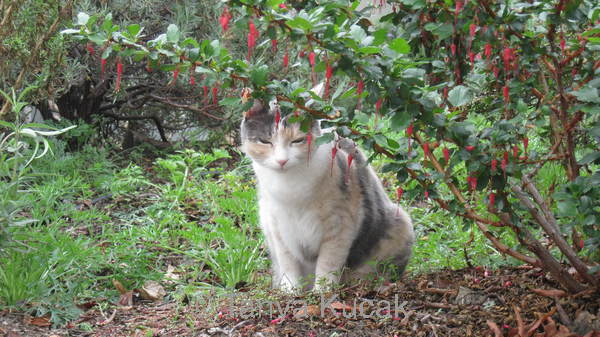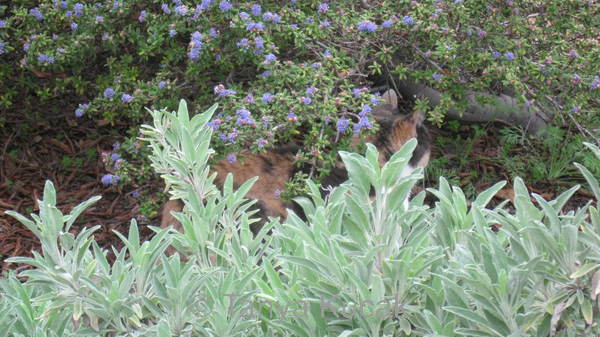
Drought is the gardening theme for 2014. I recently sat in on a meeting with Mountain View residents who are exploring waterwise gardening.
The group formed when Erin Brownfield sent the message “Anyone else ready to take out your lawn this year?” to her Monta Loma neighborhood email group. A flurry of responses encouraged her to invite Alan Whitaker, who has been gardening with natives for almost a decade, to share what he'd learned about waterwise and native plantings.
Whitaker has lived in and around the Bay Area all his life, and he has been gardening with natives since 2005. His sun-baked Monta Loma front yard is in its fourth incarnation. His grandmother introduced him to plants, so 20 years ago, his water-hungry plants were a reflection of his grandmother's garden. To reduce water use, he transitioned to succulents, and then to Australian and South African plants, but he missed the birds and bees he'd had before. Finally, in 2005 he planted drought-tolerant natives and has been hooked on them ever since.
His front yard gets no water except winter rainfall, and is hand-watered this droughty season. In mid-February, it was blooming with blue ceanothus, golden and pink-flowering currants, red gooseberry. California poppies, hummingbird fuchsia, and several buckwheats promised flowers later in the year.
One attendee got an estimate of almost $5000 for replacing 250 square feet of lawn with natives, so had an incentive to look for do-it-yourself alternatives. You can spend $2000 on mistakes of your own and feel better about it than writing a check [to a professional for the same amount], Whitaker advised.
Professionals will sell you a bunch of temporary, faster-growing plants to fill the space while the slower-growing permanent plants get up to size, he said. Half of them get overgrown and you end up with plants you don't want. But as any gardener learns, plants don't always do what they're supposed to do.
He learned from experience – by losing $600 of plants – that natives don't like soggy roots. To promote good drainage, all it takes is raising the roots a foot or two using berms. If you mound the existing soil excavated from other projects, you don't have to buy additional soil. Or you can use a sod cutter to dig up your lawn, flip the pieces of sod, and use them to create mounds.
Whitaker also suggested using urbanite to displace soil in mounds or dry streambeds. Urbanite, a plentiful material available for free, is simply chunks of concrete from demolished sidewalks or driveways. It can also be used to make low walls. A dry streambed is often featured in drought-tolerant gardens for channeling rainwater where you want it. If you dig a deep channel for the streambed, you can line it with urbanite and buy cobbles to fill it. The deeper channel can handle a larger volume of water, and using urbanite means you can spend less on purchased rock, he said.
Rather than planting single plants as he did, Whitaker said a more designed look results from choosing fewer varieties. Plant groups of 3, 5, or 7 plants of a single variety.
This year, Whitaker advised waiting until September or October before planting natives. It takes soaking rains over one or two rainy seasons, plus some supplemental water their first year or two, to help natives grow the roots that make them drought-tolerant.
This summer, he suggested, you can pay kids to dig dry streambeds, make mounds, and move earth so you'll be ready to plant in the fall.
For the rest of the yard, Whitaker said, Know what your neighbors are doing on the other side of the fence. Because his neighbors water a lot, he never has to water his fruit trees along the fence.

The lush foliage and red flowers of a native gooseberry hide the long, sharp spines that make it a great plant for wildlife cover, protecting them from predators.

In mid-February, blue ceanothus (top) as well as golden and pink flowering currants and red gooseberry were blooming in this Mountain View front yard. Sages (foreground) as well as California poppies, tansy-leaf phacelia, clarkias, hummingbird fuchsia, and several buckwheats promised flowers later in the year.

Loaded with drooping clusters of pink flowers, native currants are show-stoppers in this drought-tolerant winter garden. The lovely fragrance from the resinous leaves permeates the garden.
© 2014 Tanya Kucak